tire pressure SUBARU OUTBACK 2005 4.G User Guide
[x] Cancel search | Manufacturer: SUBARU, Model Year: 2005, Model line: OUTBACK, Model: SUBARU OUTBACK 2005 4.GPages: 627, PDF Size: 6.42 MB
Page 404 of 627
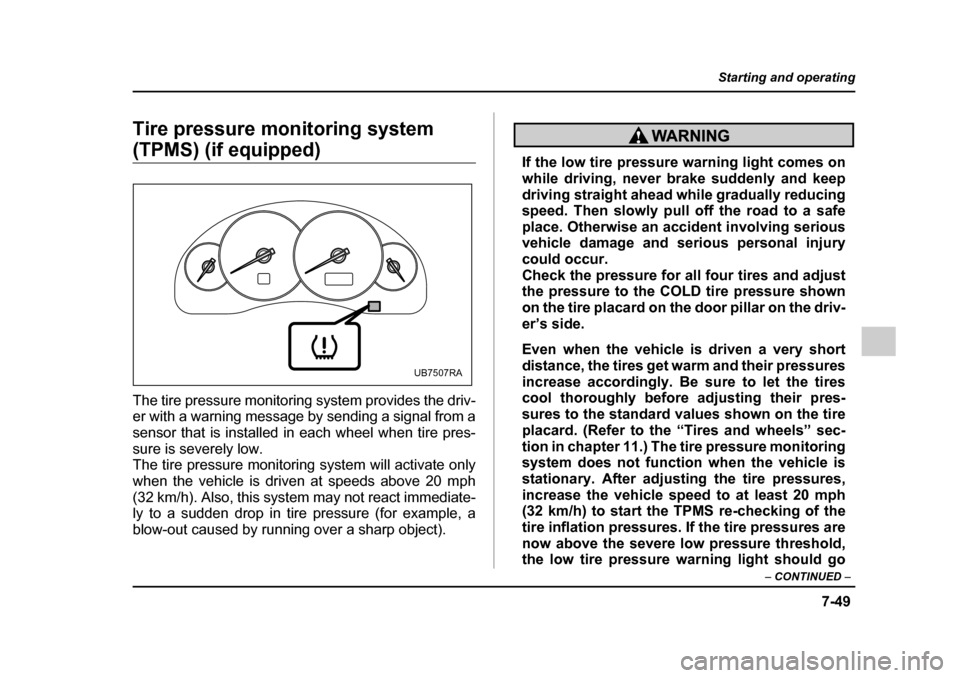
7-49
Starting and operating
– CONTINUED –
Tire pressure monitoring system
(TPMS) (if equipped)
The tire pressure monitoring system provides the driv-
er with a warning message by sending a signal from a
sensor that is installed in each wheel when tire pres-
sure is severely low.
The tire pressure monitoring system will activate only
when the vehicle is driven at speeds above 20 mph
(32 km/h). Also, this system may not react immediate-
ly to a sudden drop in tire pressure (for example, a
blow-out caused by running over a sharp object).If the low tire pressure warning light comes on
while driving, never brake suddenly and keep
driving straight ahead while gradually reducing
speed. Then slowly pull off the road to a safe
place. Otherwise an accident involving serious
vehicle damage and serious personal injury
could occur.
Check the pressure for all four tires and adjust
the pressure to the COLD tire pressure shown
on the tire placard on the door pillar on the driv-
er’s side.
Even when the vehicle is driven a very short
distance, the tires get warm and their pressures
increase accordingly. Be sure to let the tires
cool thoroughly before adjusting their pres-
sures to the standard values shown on the tire
placard. (Refer to the “Tires and wheels” sec-
tion in chapter 11.) The tire pressure monitoring
system does not function when the vehicle is
stationary. After adjusting the tire pressures,
increase the vehicle speed to at least 20 mph
(32 km/h) to start the TPMS re-checking of the
tire inflation pressures. If the tire pressures are
now above the severe low pressure threshold,
the low tire pressure warning light should go
UB7507RA
Page 405 of 627
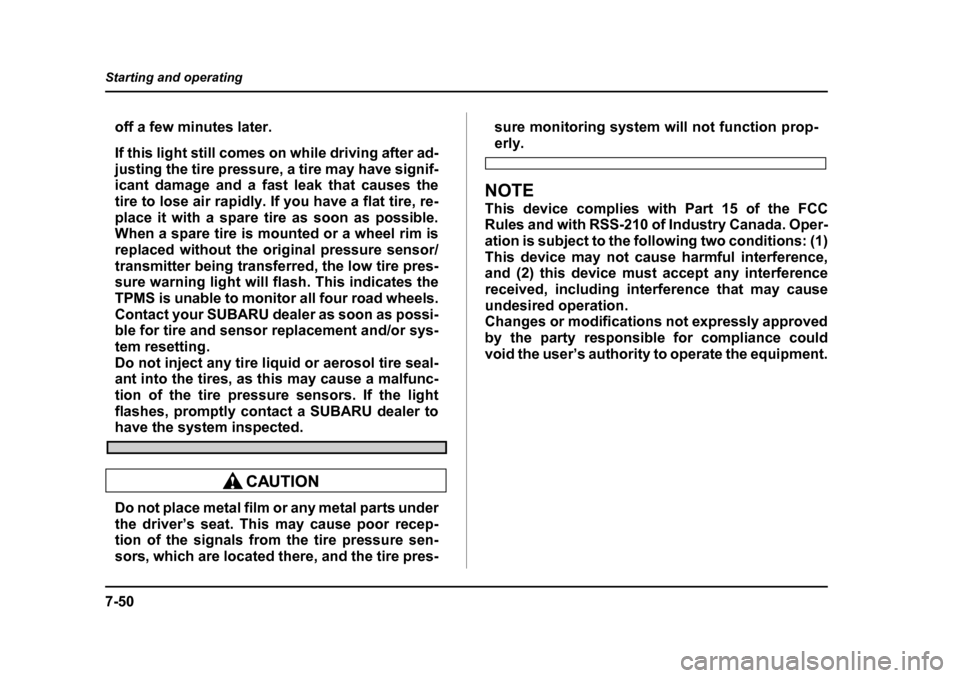
7-50
Starting and operating
off a few minutes later.
If this light still comes on while driving after ad-
justing the tire pressure, a tire may have signif-
icant damage and a fast leak that causes the
tire to lose air rapidly. If you have a flat tire, re-
place it with a spare tire as soon as possible.
When a spare tire is mounted or a wheel rim is
replaced without the original pressure sensor/
transmitter being transferred, the low tire pres-
sure warning light will flash. This indicates the
TPMS is unable to monitor all four road wheels.
Contact your SUBARU dealer as soon as possi-
ble for tire and sensor replacement and/or sys- tem resetting.
Do not inject any tire liquid or aerosol tire seal- ant into the tires, as this may cause a malfunc-
tion of the tire pressure sensors. If the light
flashes, promptly contact a SUBARU dealer to
have the system inspected.
Do not place metal film or any metal parts under
the driver’s seat. This may cause poor recep-
tion of the signals from the tire pressure sen-
sors, which are located there, and the tire pres-
sure monitoring system will not function prop-
erly.
NOTE
This device complies with Part 15 of the FCC
Rules and with RSS-210 of Industry Canada. Oper-ation is subject to the following two conditions: (1)
This device may not cause harmful interference,
and (2) this device must accept any interference
received, including interference that may cause
undesired operation.
Changes or modifications not expressly approved
by the party responsible for compliance could
void the user’s authority to operate the equipment.
Page 415 of 627
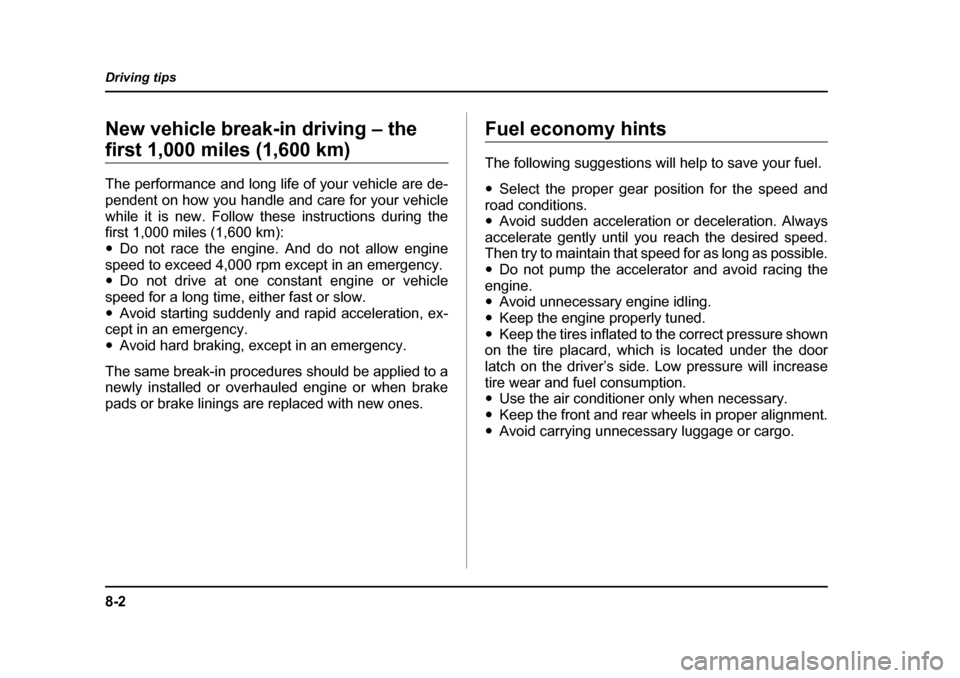
8-2
Driving tips
Driving tipsNew vehicle break-in driving – the
first 1,000 miles (1,600 km)
The performance and long life of your vehicle are de-
pendent on how you handle and care for your vehicle
while it is new. Follow these instructions during the
first 1,000 miles (1,600 km):"
Do not race the engine. And do not allow engine
speed to exceed 4,000 rpm except in an emergency." Do not drive at one constant engine or vehicle
speed for a long time, either fast or slow. " Avoid starting suddenly and rapid acceleration, ex-
cept in an emergency. " Avoid hard braking, except in an emergency.
The same break-in procedures should be applied to a
newly installed or overhauled engine or when brake
pads or brake linings are replaced with new ones.
Fuel economy hints
The following suggestions will help to save your fuel. " Select the proper gear position for the speed and
road conditions. " Avoid sudden acceleration or deceleration. Always
accelerate gently until you reach the desired speed.
Then try to maintain that speed for as long as possible. " Do not pump the accelerator and avoid racing the
engine. " Avoid unnecessary engine idling.
" Keep the engine properly tuned.
" Keep the tires inflated to the correct pressure shown
on the tire placard, which is located under the door
latch on the driver’s side. Low pressure will increase
tire wear and fuel consumption." Use the air conditioner only when necessary.
" Keep the front and rear wheels in proper alignment.
" Avoid carrying unnecessary luggage or cargo.
Page 421 of 627
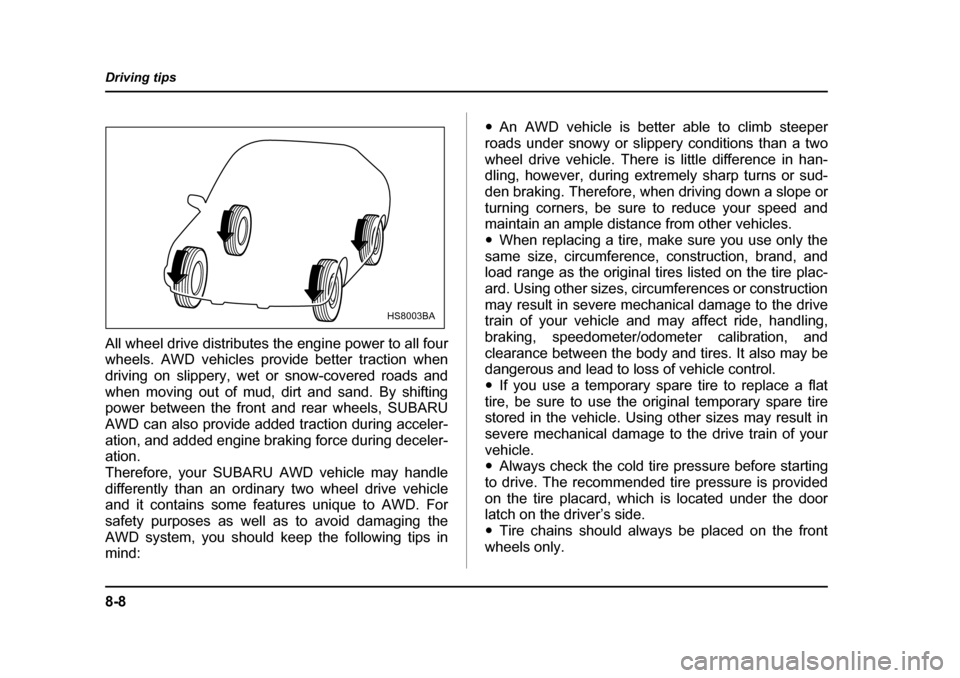
8-8
Driving tips
All wheel drive distributes the engine power to all four
wheels. AWD vehicles provide better traction when
driving on slippery, wet or snow-covered roads and
when moving out of mud, dirt and sand. By shifting
power between the front and rear wheels, SUBARU
AWD can also provide added traction during acceler-
ation, and added engine braking force during deceler-
ation.
Therefore, your SUBARU AWD vehicle may handle
differently than an ordinary two wheel drive vehicle
and it contains some features unique to AWD. For
safety purposes as well as to avoid damaging the
AWD system, you should keep the following tips in mind:
"
An AWD vehicle is better able to climb steeper
roads under snowy or slippery conditions than a two
wheel drive vehicle. There is little difference in han-
dling, however, during extremely sharp turns or sud-
den braking. Therefore, when driving down a slope or
turning corners, be sure to reduce your speed and
maintain an ample distance from other vehicles. " When replacing a tire, make sure you use only the
same size, circumference, construction, brand, and
load range as the original tires listed on the tire plac-
ard. Using other sizes, circumferences or construction
may result in severe mechanical damage to the drive
train of your vehicle and may affect ride, handling,
braking, speedometer/odometer calibration, and
clearance between the body and tires. It also may be
dangerous and lead to loss of vehicle control. " If you use a temporary spare tire to replace a flat
tire, be sure to use the original temporary spare tire
stored in the vehicle. Using other sizes may result in
severe mechanical damage to the drive train of yourvehicle. " Always check the cold tire pressure before starting
to drive. The recommended tire pressure is provided
on the tire placard, which is located under the door
latch on the driver’s side. " Tire chains should always be placed on the front
wheels only.
HS8003BA
Page 452 of 627
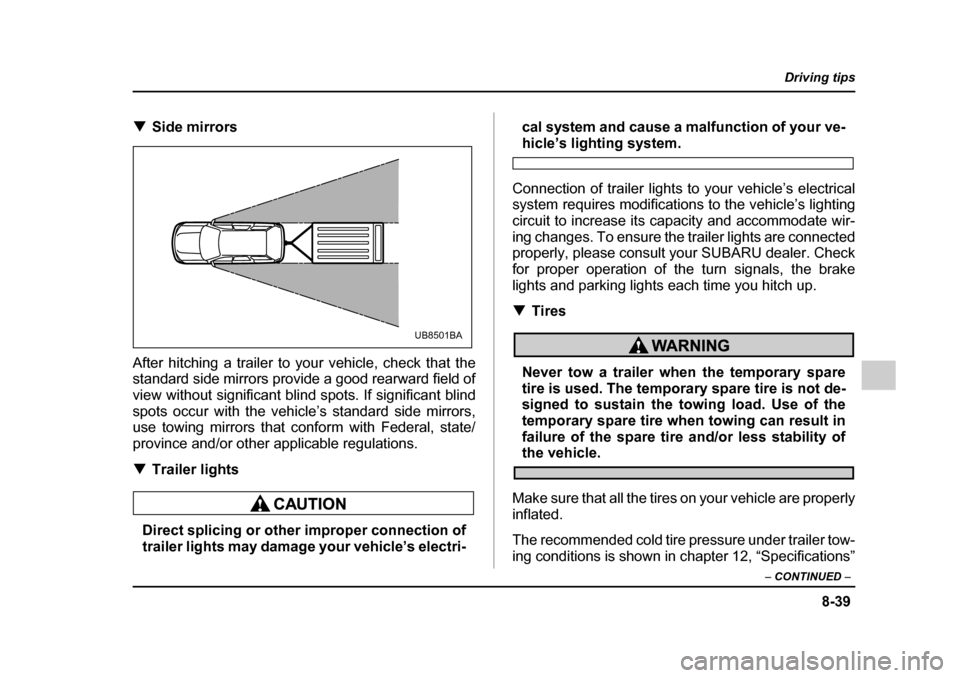
8-39
Driving tips
– CONTINUED –
!Side mirrors
After hitching a trailer to your vehicle, check that the
standard side mirrors provide a good rearward field of
view without significant blind spots. If significant blind
spots occur with the vehicle’s standard side mirrors,
use towing mirrors that conform with Federal, state/
province and/or other applicable regulations. ! Trailer lights
Direct splicing or other improper connection of
trailer lights may damage your vehicle’s electri- cal system and cause a malfunction of your ve-
hicle’s lighting system.
Connection of trailer lights to your vehicle’s electrical
system requires modifications to the vehicle’s lighting
circuit to increase its capacity and accommodate wir-
ing changes. To ensure the trailer lights are connected
properly, please consult your SUBARU dealer. Check
for proper operation of the turn signals, the brake
lights and parking lights each time you hitch up. ! Tires
Never tow a trailer when the temporary spare
tire is used. The temporary spare tire is not de-
signed to sustain the towing load. Use of the
temporary spare tire when towing can result in
failure of the spare tire and/or less stability of
the vehicle.
Make sure that all the tires on your vehicle are properly
inflated.
The recommended cold tire pressure under trailer tow-
ing conditions is shown in chapter 12, “Specifications”
UB8501BA
Page 453 of 627
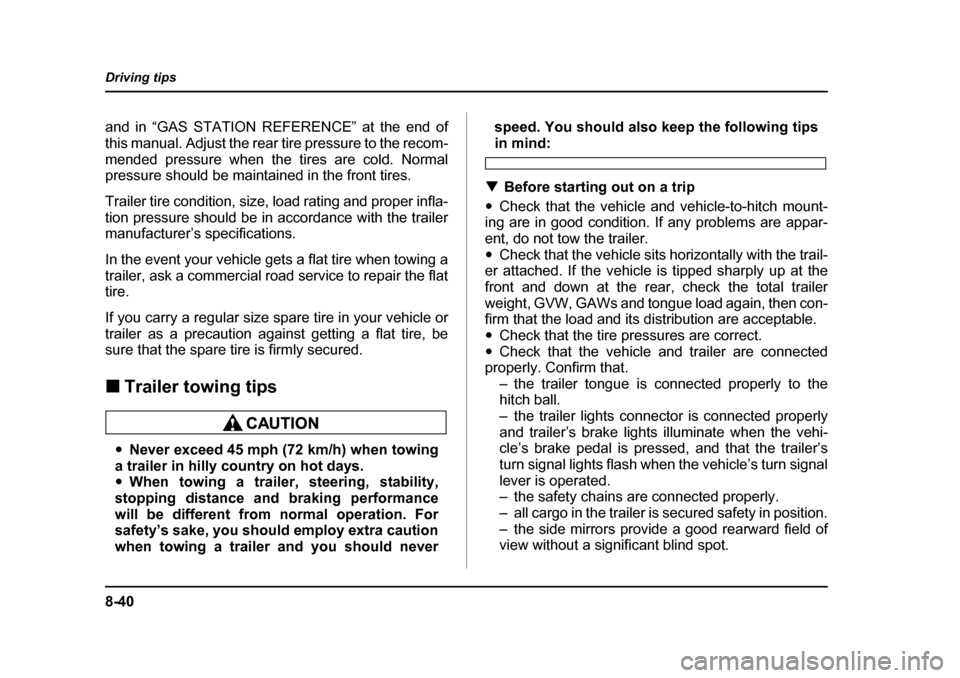
8-40
Driving tips
and in “GAS STATION REFERENCE” at the end of
this manual. Adjust the rear tire pressure to the recom-
mended pressure when the tires are cold. Normal
pressure should be maintained in the front tires.
Trailer tire condition, size, load rating and proper infla-
tion pressure should be in accordance with the trailer
manufacturer’s specifications.
In the event your vehicle gets a flat tire when towing a
trailer, ask a commercial road service to repair the flat tire.
If you carry a regular size spare tire in your vehicle or
trailer as a precaution against getting a flat tire, be
sure that the spare tire is firmly secured. !
Trailer towing tips
"Never exceed 45 mph (72 km/h) when towing
a trailer in hilly country on hot days. " When towing a trailer, steering, stability,
stopping distance and braking performance
will be different from normal operation. For
safety’s sake, you should employ extra caution
when towing a trailer and you should never speed. You should also keep the following tips
in mind:
! Before starting out on a trip
" Check that the vehicle and vehicle-to-hitch mount-
ing are in good condition. If any problems are appar-
ent, do not tow the trailer." Check that the vehicle sits horizontally with the trail-
er attached. If the vehicle is tipped sharply up at the
front and down at the rear, check the total trailer
weight, GVW, GAWs and tongue load again, then con-
firm that the load and its distribution are acceptable. " Check that the tire pressures are correct.
" Check that the vehicle and trailer are connected
properly. Confirm that.
– the trailer tongue is connected properly to the
hitch ball.
– the trailer lights connector is connected properly
and trailer’s brake lights illuminate when the vehi-
cle’s brake pedal is pressed, and that the trailer’s
turn signal lights flash when the vehicle’s turn signal
lever is operated.
– the safety chains are connected properly.
– all cargo in the trailer is secured safety in position.
– the side mirrors provide a good rearward field of
view without a significant blind spot.
Page 456 of 627

9-1
9
In case of emergency
If you park your vehicle in an emergency .. 9-2
Temporary spare tire .................................... 9-3
Flat tires ......................................................... 9-5 Changing a flat tire ........................................... 9-5
Tire pressure monitoring system (TPMS) (if equipped) .................................................... 9-16
Jump starting ................................................ 9-17 How to jump start ............................................. 9-18
Engine overheating ....................................... 9-20 If steam is coming from the engine compartment .................................................. 9-20
If no steam is coming from the engine compartment .................................................. 9-20
Towing ........................................................... 9-21 Towing and tie-down hooks ............................ 9-22
Using a flat-bed truck ....................................... 9-27
Towing with all wheels on the ground ............ 9-28
Rear gate – if the rear gate cannot be unlocked ..................................................... 9-29
Moonroof – if the moonroof cannot be closed ......................................................... 9-30
Maintenance tools ......................................... 9-33 Jack .................................................................... 9-33
Jack handle ....................................................... 9-34
Other maintenance tools .................................. 9-35
Page 458 of 627
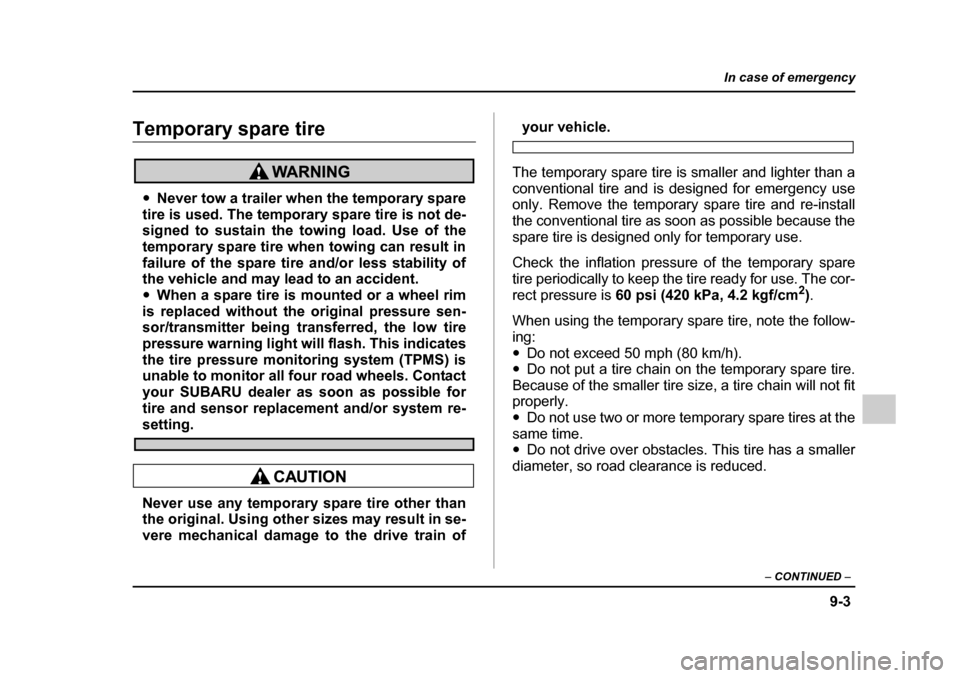
9-3
In case of emergency
– CONTINUED –
Temporary spare tire
"Never tow a trailer when the temporary spare
tire is used. The temporary spare tire is not de-
signed to sustain the towing load. Use of the
temporary spare tire when towing can result in
failure of the spare tire and/or less stability of
the vehicle and may lead to an accident. " When a spare tire is mounted or a wheel rim
is replaced without the original pressure sen-
sor/transmitter being transferred, the low tire
pressure warning light will flash. This indicates
the tire pressure monitoring system (TPMS) is
unable to monitor all four road wheels. Contact
your SUBARU dealer as soon as possible for
tire and sensor replacement and/or system re-
setting.
Never use any temporary spare tire other than
the original. Using other sizes may result in se-
vere mechanical damage to the drive train of
your vehicle.
The temporary spare tire is smaller and lighter than a
conventional tire and is designed for emergency use
only. Remove the temporary spare tire and re-install
the conventional tire as soon as possible because the
spare tire is designed only for temporary use.
Check the inflation pressure of the temporary spare
tire periodically to keep the tire ready for use. The cor-
rect pressure is 60 psi (420 kPa, 4.2 kgf/cm 2
).
When using the temporary spare tire, note the follow-
ing: " Do not exceed 50 mph (80 km/h).
" Do not put a tire chain on the temporary spare tire.
Because of the smaller tire size, a tire chain will not fit
properly. " Do not use two or more temporary spare tires at the
same time. " Do not drive over obstacles. This tire has a smaller
diameter, so road clearance is reduced.
Page 471 of 627
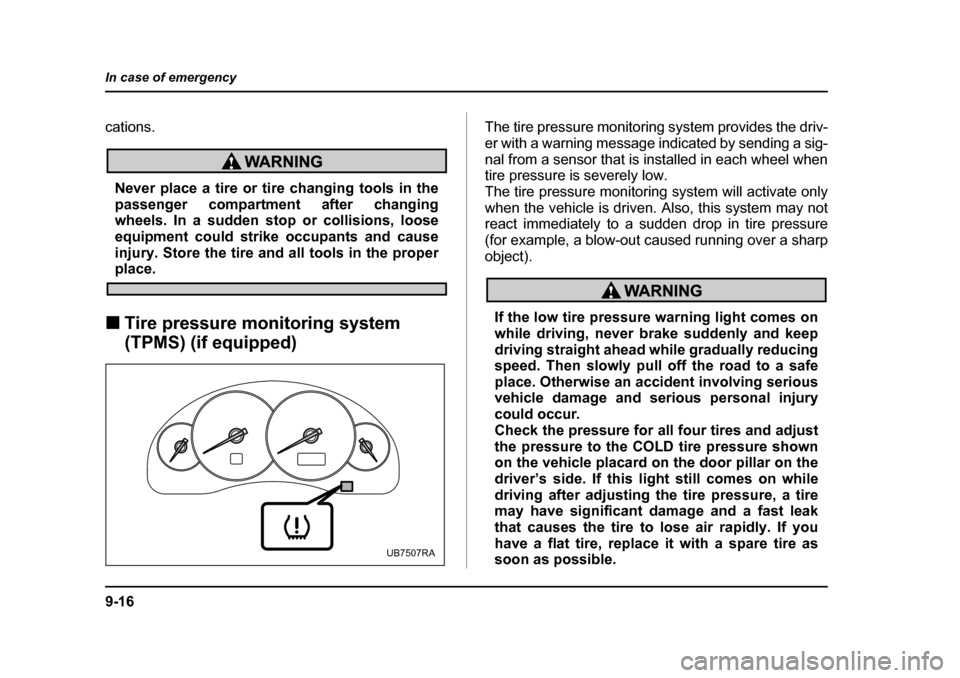
9-16
In case of emergency
cations.
Never place a tire or tire changing tools in the
passenger compartment after changing
wheels. In a sudden stop or collisions, loose
equipment could strike occupants and cause
injury. Store the tire and all tools in the proper
place.
! Tire pressure monitoring system
(TPMS) (if equipped) The tire pressure monitoring system provides the driv-
er with a warning message indicated by sending a sig-
nal from a sensor that is installed in each wheel when
tire pressure is severely low.
The tire pressure monitoring system will activate only
when the vehicle is driven. Also, this system may not
react immediately to a sudden drop in tire pressure
(for example, a blow-out caused running over a sharp
object).
If the low tire pressure warning light comes on
while driving, never brake suddenly and keep
driving straight ahead while gradually reducing
speed. Then slowly pull off the road to a safe
place. Otherwise an accident involving serious
vehicle damage and serious personal injury
could occur.
Check the pressure for all four tires and adjust
the pressure to the COLD tire pressure shown
on the vehicle placard on the door pillar on the
driver’s side. If this light still comes on while
driving after adjusting the tire pressure, a tire
may have significant damage and a fast leak
that causes the tire to lose air rapidly. If you
have a flat tire, replace it with a spare tire as
soon as possible.
UB7507RA
Page 472 of 627
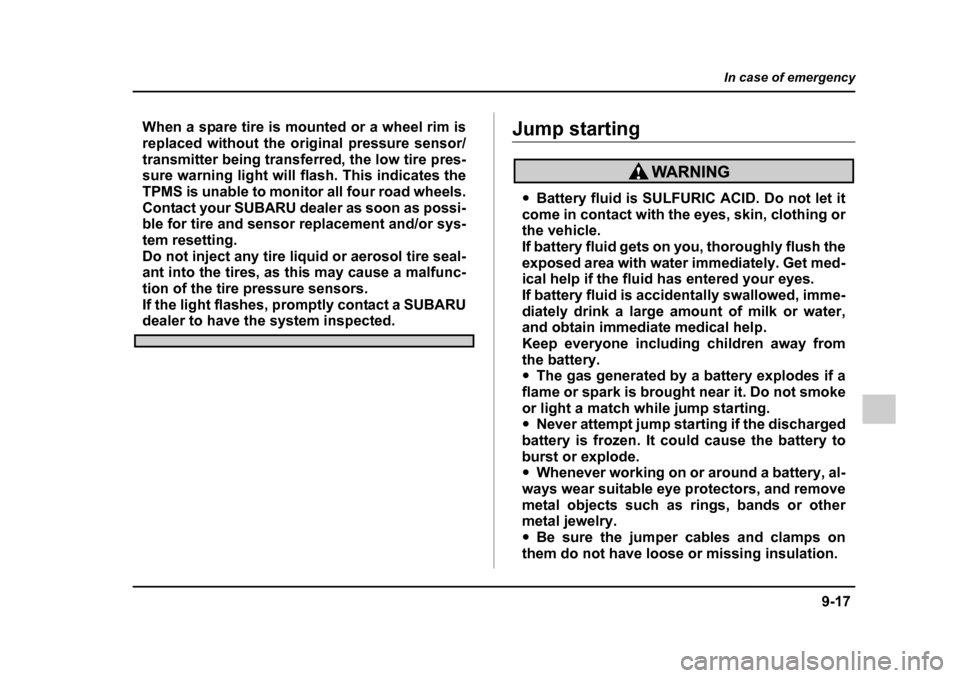
9-17
In case of emergency
– CONTINUED –
When a spare tire is mounted or a wheel rim is
replaced without the original pressure sensor/
transmitter being transferred, the low tire pres-
sure warning light will flash. This indicates the
TPMS is unable to monitor all four road wheels.
Contact your SUBARU dealer as soon as possi-
ble for tire and sensor replacement and/or sys-
tem resetting.
Do not inject any tire liquid or aerosol tire seal-
ant into the tires, as this may cause a malfunc-
tion of the tire pressure sensors.
If the light flashes, promptly contact a SUBARU
dealer to have the system inspected.
Jump starting
"Battery fluid is SULFURIC ACID. Do not let it
come in contact with the eyes, skin, clothing or
the vehicle.
If battery fluid gets on you, thoroughly flush the
exposed area with water immediately. Get med-
ical help if the fluid has entered your eyes.
If battery fluid is accidentally swallowed, imme-
diately drink a large amount of milk or water,
and obtain immediate medical help.
Keep everyone including children away from the battery." The gas generated by a battery explodes if a
flame or spark is brought near it. Do not smoke
or light a match while jump starting." Never attempt jump starting if the discharged
battery is frozen. It could cause the battery to
burst or explode." Whenever working on or around a battery, al-
ways wear suitable eye protectors, and remove
metal objects such as rings, bands or other
metal jewelry. " Be sure the jumper cables and clamps on
them do not have loose or missing insulation.